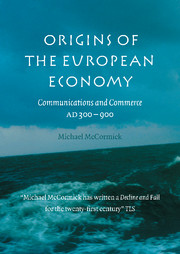Book contents
- Frontmatter
- Dedication
- Contents
- List of maps
- List of figures
- List of tables
- List of charts
- Preface
- List of abbreviations
- Commerce, communications, and the origins of the European economy
- PART I THE END OF THE WORLD
- 1 The end of the ancient world
- 2 Late Roman industry: case studies in decline
- 3 Land and river communications in late antiquity
- 4 Sea change in late antiquity
- The end of the ancient economy: a provisional balance sheet
- PART II PEOPLE ON THE MOVE
- PART III THINGS THAT TRAVELED
- PART IV THE PATTERNS OF CHANGE
- PART V COMMERCE
- Appendices
- Bibliography
- Index
3 - Land and river communications in late antiquity
from PART I - THE END OF THE WORLD
Published online by Cambridge University Press: 05 February 2015
- Frontmatter
- Dedication
- Contents
- List of maps
- List of figures
- List of tables
- List of charts
- Preface
- List of abbreviations
- Commerce, communications, and the origins of the European economy
- PART I THE END OF THE WORLD
- 1 The end of the ancient world
- 2 Late Roman industry: case studies in decline
- 3 Land and river communications in late antiquity
- 4 Sea change in late antiquity
- The end of the ancient economy: a provisional balance sheet
- PART II PEOPLE ON THE MOVE
- PART III THINGS THAT TRAVELED
- PART IV THE PATTERNS OF CHANGE
- PART V COMMERCE
- Appendices
- Bibliography
- Index
Summary
Profound shifts in the economy, culture, and political structures of late antiquity precipitated deep changes in how – and how much – people and things moved long distances. Transport and communications played a key role in the transformations of the ancient world. Transport is the bridge that links the critical factors of supply and demand over distance. The communications it allows channel the movements of people, who bring with them their distinctive cultural baggage, with all the consequences such contacts entail for cultural effervescence. Linking supply and demand over distance is essential to economic specialization which, in turn, is critical to economic growth. In fact, despite broad ecological similarities around the shores of the Mediterranean Sea, Roman transportation and communications had fostered some regional specialization and interdependence in earlier centuries, as we have already seen from the history of mining and dish-ware production. This chapter will consider some of the main changes that affected key systems of land and river communications. The next one will turn to the sea. But first we need to clarify a few general concepts and conditions.
Routes, ships, and men
Some changes afoot in the last centuries of antiquity affected the basic structures of communications, that is, the physical plant of wagons, animals, ships, roads, ports, and routes. They also influenced the directions, frequency, and speed of land and water travel. They modified their volume in aggregate and along certain axes.
- Type
- Chapter
- Information
- Origins of the European EconomyCommunications and Commerce AD 300–900, pp. 64 - 82Publisher: Cambridge University PressPrint publication year: 2002



